Sewage Treatment Potential of Water Hyacinth (Eichhornia crassipes)
Abstract
Pollution of water and soil is a major environmental problem and day by day, this problem is increasing with the rapid growth of industrialization and urbanization in all parts of the world. Most conventional remediation approaches do not provide acceptable solution to pollution problem. The use of special plants for environmental clean-up is an emerging technology called Phytoremediation. This paper is an attempt to study the Phytoremediation efficiency of Water Hyacinth (Eichhornia crassipes). It has been concluded that this plant emerged is a potent tool for treatment of the municipal waste.
Pollution of water and soil is a major environmental problem and day by day, this problem is increasing with the rapid growth of industrialization and urbanization in all parts of the world. Most conventional remediation approaches do not provide acceptable solution to pollution problem. The use of special plants for environmental clean-up is an emerging technology called Phytoremediation. This paper is an attempt to study the Phytoremediation efficiency of Water Hyacinth (Eichhornia crassipes). It has been concluded that this plant emerged is a potent tool for treatment of the municipal waste.
| How to cite this article: S.H. Dar, D.M. Kumawat, N. Singh and K.A. Wani, 2011. Sewage Treatment Potential of Water Hyacinth (Eichhornia crassipes). Research Journal of Environmental Sciences, 5: 377-385. DOI: 10.3923/rjes.2011.377.385 URL: https://scialert.net/abstract/?doi=rjes.2011.377.385 |
INTRODUCTION
Water pollution now a day is considered not only in terms of public health but also in terms of conservation, aesthetic and preservation of natural beauty and resources. Major lakes, rivers, reservoirs of the world are now getting polluted by various ways and there by posing threat to the survivability of the life system on these diverse water bodies. The depletion of Fresh water resources could very well create the resource crisis of the 21st Century bringing up agriculture industrial, domestic as well as international conflicts (Kumar, 2003). Regular monitoring of these contaminating routes and their effective protective action plan has to be evolved for better control of water pollution.
Water consists of an exceptional quality of dissolving a number of substances without changing their chemical and therefore, plays an important role in transporting materials in the body. In the higher plants, the nutrients are carried from roots to other parts in water through xylem (Goel, 2006).
Water scarcity is likely to become more problematic in the near future due to rapid population growth, increasing per capita water consumption and geographical disparities between centers of population growth and availability of water (Postel, 1998). Therefore, technologies of wastewater management, which are simple, practical, economical, environmental friendly and capable of recycling or generating resources would be most desirable (Polprasert, 1996).
Synthetic dyes and heavy metals are widely used in the industries like textiles, leather, paper, plastics, electroplating, cement, metal processing, wood preservatives, paints, pigments and steel fabricating industries (Ponnusami et al., 2008). These industries discharge large quantities of toxic wastes and the untreated effluents from these industries cause soil and water pollution, which results in the accumulation of heavy metals and colour to the water. Heavy metals are toxic even at very low concentrations and pose serious problems due to their possible entry into the food chain (Vasanthy et al., 2004). Colour is a visible pollutant and presence of very minute concentration of colouring substances in water makes it unsuitable for domestic purposes like drinking and recreational purposes due to its anesthetic appearance (Vasanth Kumar et al., 2003).
Though phytoremediation has a long history of over 300 years, its industrial and environmental applications are quite recent. Besides Micro organisms plants are also being studied for their potential of environmental cleanup. Green plants are not only the lungs of nature with an ability of purifying impure air by photosynthesis but some species have also the unique ability to uptake, tolerate and even hyperaccumulate heavy metals and other toxic substances from soil and water through their roots and concentrate them in roots, stems and leaves. These include some aquatic weeds, such as Salvinia, Lemna, Azolla and Eichhornia sedges like Typha latifolia and some herbaceous as well as woody plant. The present study was undertaken to study the treatment performance of water hyacinth in domestic wastewater collected from Mahananda Nagar Ujjain (MP).
MATERIALS AND METHODS
Preliminary studies: A review of literature was done about the role of aquatic weeds in wastewater treatment. After that local survey was conducted from January to June 2010 and one aquatic weed was selected for our study, i.e., Eichhornia crassipes. E. crassipes is a free floating hydrophyte. In the present study, the test plants (Eichhornia crassipes) were collected from river Kshipra near Mangalnath Temple which is considered as a holy river in India.
The Wastewater (Municipal) poses a great problem to environmentalists. Day by day water consumption increases due to increase in population and increase in life standard of people. For our study, we collect waste water from Mahananda Nagar Ujjain.
Experimental set up: The test plants (Weight taken after keeping them on a filter paper to remove excess water) were transferred to plastic troughs having capacity of five liters containing waste water in different concentrations. Before transferring plants into troughs, an initial analysis of main physical, chemical and biological parameters was done. The experiment was divided into five sets with three triplicates of each:
Set 1: 25% Wastewater + 75% Tapwater
Set 2: 50% Wastewater + 50% Tapwater
Set 3: 75% Wastewater + 25% Tapwater
Set 4: 100% Wastewater
Set 5: Control (Tap water without Dilution)
Set 2: 50% Wastewater + 50% Tapwater
Set 3: 75% Wastewater + 25% Tapwater
Set 4: 100% Wastewater
Set 5: Control (Tap water without Dilution)
The experiment was performed in the Department of Environment Management, Vikram University Ujjain (MP).
After 15 days, the analysis of treated water was taken for different physical, chemical and biological parameters. In addition to analysis, the effect of plants was also noticed. This experiment was repeated several times and finally data has been interpreted on average basis.
Preservation of samples: Suggested chemical preservatives and recommended maximum storage times for samples for various analyses are summarized in the following Table 1.
| Table 1: | Different preservation methods for various physico chemical parameters |
 | |
| Table 2: | Physico-chemical and Biological Analysis of wastewater |
 | |
Selection of determinants: To assess an understanding of the nature of wastewater and treated water by water hyacinth, following determinants were presented in the following sections.
Chemical properties: The discussion on chemical characteristics of domestic wastewater and treated water is presented as measurement of organic contents like pH and gas (dissolved oxygen). The main stress was given at monitoring of nitrogen species like - Total Kjeldhal Nitrogen (TKN), ammonium nitrogen, nitrate nitrogen and COD.
Biological properties: For the treatment of domestic waste water, the knowledge of biological characteristics is essential. The main thrust was on BOD.
Procedures: Standard analytical methods were followed in recording the data, field measurement and laboratory analytical techniques (Table 2).
RESULTS AND DISCUSSION
Phytoremediation is a new area of biotechnology that takes advantage of fact that certain species of plants and fungi flourish by accumulating waste materials present in the water. It may be applied wherever the static water or soil environment has become polluted or is suffering ongoing chronic pollution. Phytoremediation refers to the natural ability of certain plants called hyperaccumulators to bioaccumulate, degrade or render harmless contaminants in water, air or soil. Phytotechnologies involving use of plants for pollutant removal gained importance during the last two decades. Contaminants such as metals, pesticides, solvents, crude oil and its derivatives have been mitigated in phytoremediation projects worldwide. It is considered a clean, cost-effective and non- environmentally disruptive technology as opposed to mechanical cleanup methods, such as pumping polluted ground water or soil excavation. . A new technology, sewage purification by water hyacinth (Eichhornia crassipes) is a possible solution (Alade and Ojoawo, 2009).
The present work utilizes the response of a free floating aquatic weed (Eichhornia Crassipes) to evaluate the remediation of various waste water pollutants. This weed is well known for its reproduction potential (DeCasabianca and Laugier, 1995) and as a plant that can double its population in twelve days. It has an ability to grow in severe polluted waters and thus it can improve the effluent quality from oxidation ponds and as a main component of one integrated advanced system for treatment of municipal, Agricultural and industrial wastewaters.
The results indicate that, the test plant (Eichhornia crassipes) reduced all the physic-chemical and biological parameters to a significant level in all dilutions (i.e., 25, 50, 75 and 100% waste waters) as shown in Fig. 1 and 2. However, the dissolved oxygen (DO) showed an increasing trend to a significant level.
The pH level reduced to 7.2 from 7.8 after treatment which clearly indicates Eichhornia crassipes can be used in areas where the acidity of soil is very high (Fig. 1). The total dissolved solid reduction by test plant (Eichhornia crassipes) was good in almost all concentrations (Fig. 2). There occurred a 61% decrease in 25% wastewater concentration, while as highest occurs in 100% wastewater. It reduced 66% of Total Dissolved Solids. The root of water hyacinth acts like living substrate for attached microorganisms which then provide a significant degree of treatment thanks to their metabolism (USEPA, 1988). Besides enabling growth of microbial colonies root system is also good medium for filtration and adsorption of suspended materials, nutrients and heavy metals (Center et al., 2002).
As far as Conductivity is concerned, water hyacinth decreased the conductivity of all the concentrations. But, it was maximum in 75% wastewater where it decreased from 24.90 m mhos to 13.6 μ mhos (Fig. 3).
Hardness is defined as the concentration of multivalent metallic cations (Ca2+, Mg2+, Sr2+, Fe2+) in solution. The hardness of water varies from place to place. Water hyacinth is unable to lower hardness in 25% concentration too much.
 | |
| Fig. 1: | The values of pH before and after treatment |
 | |
| Fig. 2: | Treatment performance in TDS by water hyacinth |
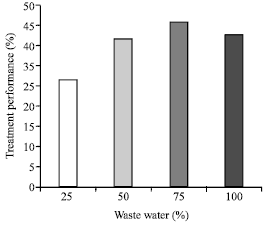 | |
| Fig. 3: | Reduction potential (%) of water hyacinth in conductivity |
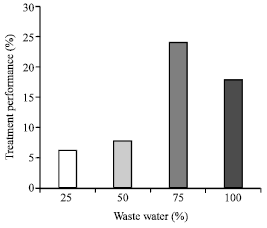 | |
| Fig. 4: | Removal of hardness by the test plant (E. crassipes) |
While it shows maximum reduction in 75% wastewater. It showed performance efficiency of 24% in 75% wastewater (Fig. 4).
The level of DO in any water shows condition of pollution level. In our study, water hyacinth increased the DO level in all wastewater samples . It showed an increase from 0 to 100% in 75 and 100% wastewaters around 2.5 mg L-1 in both. Thus it shows that DO level is increased by the water hyacinth (Fig. 5).
The BOD removal by water hyacinth in different concentrations shows that it cannot perform well in 100% wastewater having high BOD value. In our study (Fig. 6) we found that, it reduced maximum BOD level in 75% wastewater and almost same in 25 and 50% wastewaters. It indicates that too much dilution in wastewater hampered the performance of the test plant, i.e., Eichhornia crassipes.
The test plant (Eichhornia crassipes) shows maximum reduction of COD in 75% wastewater, while minimum in 25% wastewater and in 100% wastewater it shows the treatment performance of 46% (Fig. 7).
Nitrogen present in wastewater may be in many forms NO3N, NH3N, NO2N and Organic Nitrogen. Plants grown in wastewater containing nitrogen in many forms as pollutants may be utilized by plants in many ways. Rogers and Davis (1972) concluded plant uptake as the dominant removal mechanism for N. Nitrification-Denitrification complex has been established as the major removal mechanism for nitrogen.
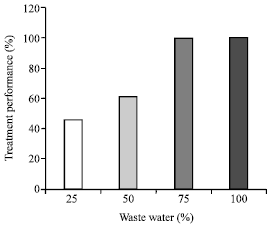 | |
| Fig. 5: | Increasing level of DO by water hyacinth |
 | |
| Fig. 6: | BOD removal efficiency (%) of water hyacinth |
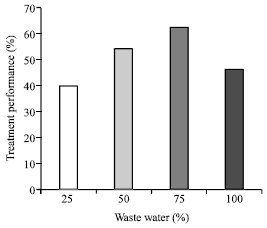 | |
| Fig. 7: | COD removal efficiency (%) of water hyacinth |
In the present study, the test plants (Eichhornia Crassipes) removed Nitrogen considerably in all concentrations as shown in Fig. 8. Maximum removal was found in 50% wastewater. Efficiency of nitrogen removal by Eichhornia Crassipes ranges from 10 to 90% (USEPA, 1988).
As far as Nitrate Nitrogen is concerned, water hyacinth reduced maximum in 25% wastewater and minimum in 100% wastewater Fig. 9. While as ammonium nitrogen removal is shown maximum by 75 and 100% wastewaters (Fig. 10).
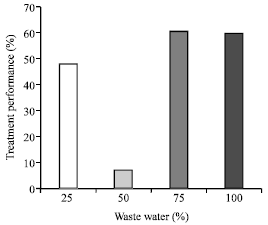 | |
| Fig. 8: | Treatment potential (%) of water hyacinth in total nitrogen hyacinth |
 | |
| Fig. 9: | Removal efficiency (%) of nitrate nitrogen by water hyacinth |
 | |
| Fig. 10: | Removal efficiency (%) of ammonium nitrogen by water |
This may be due to high pH, while as minimum by 50% wastewater.
CONCLUSION
Water environment has been polluted and is suffering from ongoing chronic pollution. This has become one of the most pervasive environmental problems throughout the world. Although, control technologies have been applied at many industrial and municipal establishments. The problem will remain still intact with ever increasing population, human urge for better living and developmental activities. High cost technologies though effective cannot be employed by most developing countries including India. So, we have to find alternative cost effective methods; one such system could be the phytoremediation. Phytoremediation is a potential remediation strategy that can be used to treat water contaminated with pollutants.
In the present study, an attempt was made to find the potential of water Hyacinth in the treatment of domestic wastewater. Various physical, chemical and biological parameters were studied and it was observed, that water hyacinth is a potential tool for treating municipal wastewater. The plant performed well in 100% wastewater. It may be used for at least primary and secondary treatment, if artificial aquatic systems are developed in a proper way. This plant might be utilized as an efficient, economical and ecological alternative to accelerate the removal and degradation of agro-industrial wastewater pollutants.
The present study still need further research to investigate the role of water hyacinth in detail with special reference to any effect on other living forms and its potential to remove toxic chemicals present in our environment.
APHA, 1976. Standard Methods of the Examination of Water/Waste Water. 14th Edn., APHA, AWWA and WPCF, New York.
APHA., 1992. Standard Methods for the Examination of Water and Wastewater. 17th Edn., American Public Health Association, Washington, DC., USA., ISBN-13: 9780875532073, Pages: 981.
Alade, G.A. and S.O. Ojoawo, 2009. Purification of domestic sewage by water-hyacinth (Eichhornia crassipes). Int. J. Environ. Technol. Manage., 10: 286-294.
Direct Link |
Bremner, J.M. and D.R. Keeney, 1965. Steam distillation methods of determination of ammonium, nitrate and nitrite. Anal. Chem. Acta, 32: 485-495.
CrossRef |
Center, T.D., M.P. Hill, H. Cordo and M.H. Julien, 2002. Waterhyacinth. In: Biological Control of Invasive Plants in the Eastern United Statesm, Van Driesche, R. (Ed.). USDA Forest Service Publication, Washington, DC.
De Casabianca, M.L. and T. Laugier, 1995. Eichhornia crassipes production on petroliferous wastewaters: Effects of salinity. Bioresour. Technol., 54: 39-43.
CrossRef | Direct Link |
Goel, P.K., 2006. Water Pollution Causes Effects and Control. New Age International Publishers, New Delhi.
Jackson, M. and R.W. Andrew, 1996. Environmental Science. Longman Group Ltd., England.
Polprasert, C., 1996. Organic Waste Recycling-Technology and Management. John Wiley and Sons Inc., Chichester, West Sussex, England.
Ponnusami, V., N. Lavanya, M. Meenal, R.A.J. Raj and S.N. Srivastava, 2008. Application of nitric acid treated rice husk for sorption of reactive dye, reactive Black 5-analysis using statistical experimental design. Pollut. Res., 27: 45-48.
Postel, S.L., 1998. Water for food production: Will there be enough in 2025. BioScience, 48: 629-637.
Direct Link |
Rogers, H.H. and D.E. Davis, 1972. Nutrient removal by waterhyacinth. Weed Sci., 20: 423-428.
Direct Link |
USEPA, 1988. Design Manual-constructed Wetlands and Aquatic Systems for Municipal Waste Water Treatment. US Environmental Protection Agency Office of Research and Development, Cincinnati, OH., pp: 83.
Vasanth Kumar, K. and D.V.S. Bhagavanulu, 2003. Adsorption of basic dye from its aqueous solution onto bio-organic waste (Part 4: Hydrodynamic and equilibrium studies). J. Industrial Pollut. Control, 19: 165-172.
Vasanthy, M., M. Sangeetha and R. Kalaiselvi, 2004. A comparative study on the chromium removal efficiency of fly ash and commercial activated carbon. J. Industrial Pollut. Control, 20: 37-37.
APHA., 1992. Standard Methods for the Examination of Water and Wastewater. 17th Edn., American Public Health Association, Washington, DC., USA., ISBN-13: 9780875532073, Pages: 981.
Alade, G.A. and S.O. Ojoawo, 2009. Purification of domestic sewage by water-hyacinth (Eichhornia crassipes). Int. J. Environ. Technol. Manage., 10: 286-294.
Direct Link |
Bremner, J.M. and D.R. Keeney, 1965. Steam distillation methods of determination of ammonium, nitrate and nitrite. Anal. Chem. Acta, 32: 485-495.
CrossRef |
Center, T.D., M.P. Hill, H. Cordo and M.H. Julien, 2002. Waterhyacinth. In: Biological Control of Invasive Plants in the Eastern United Statesm, Van Driesche, R. (Ed.). USDA Forest Service Publication, Washington, DC.
De Casabianca, M.L. and T. Laugier, 1995. Eichhornia crassipes production on petroliferous wastewaters: Effects of salinity. Bioresour. Technol., 54: 39-43.
CrossRef | Direct Link |
Goel, P.K., 2006. Water Pollution Causes Effects and Control. New Age International Publishers, New Delhi.
Jackson, M. and R.W. Andrew, 1996. Environmental Science. Longman Group Ltd., England.
Polprasert, C., 1996. Organic Waste Recycling-Technology and Management. John Wiley and Sons Inc., Chichester, West Sussex, England.
Ponnusami, V., N. Lavanya, M. Meenal, R.A.J. Raj and S.N. Srivastava, 2008. Application of nitric acid treated rice husk for sorption of reactive dye, reactive Black 5-analysis using statistical experimental design. Pollut. Res., 27: 45-48.
Postel, S.L., 1998. Water for food production: Will there be enough in 2025. BioScience, 48: 629-637.
Direct Link |
Rogers, H.H. and D.E. Davis, 1972. Nutrient removal by waterhyacinth. Weed Sci., 20: 423-428.
Direct Link |
USEPA, 1988. Design Manual-constructed Wetlands and Aquatic Systems for Municipal Waste Water Treatment. US Environmental Protection Agency Office of Research and Development, Cincinnati, OH., pp: 83.
Vasanth Kumar, K. and D.V.S. Bhagavanulu, 2003. Adsorption of basic dye from its aqueous solution onto bio-organic waste (Part 4: Hydrodynamic and equilibrium studies). J. Industrial Pollut. Control, 19: 165-172.
Vasanthy, M., M. Sangeetha and R. Kalaiselvi, 2004. A comparative study on the chromium removal efficiency of fly ash and commercial activated carbon. J. Industrial Pollut. Control, 20: 37-37.
No comments:
Post a Comment